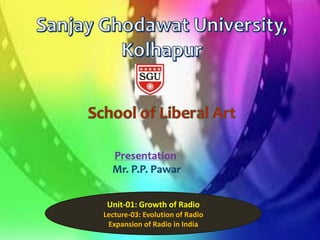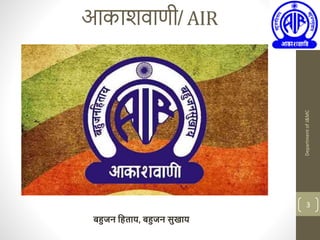Lecture-03.pptx
- 1. Department of Journalism and Mass Communication Presentation: Mr.P.P.Pawar Assistant Professor in Mass Communication and Journalism Sanjay Ghodawat University, Kolhapur Unit-01: Growth of Radio Lecture-03: Evolution of Radio Expansion of Radio in India
- 2. Unit-01:Growth of Radio Out come of the unit: Recall1 growth of Radio Sub Topic: History of Radio in India Objective: At the end of this sub topic students will able to - Explain History of Radio in India - Growth and development of Radio in India - Current situation of Radio in India Department of J&MC 2
- 3. āĪāĪāĪūāĪķāĪĩāĪūāĪĢāĨ/ AIR Department of J&MC 3 āĪŽāĪđāĨāĪāĪĻ āĪđāĪŋāĪĪāĪūāĪŊ, āĪŽāĪđāĨāĪāĪĻ āĪļāĨāĪāĪūāĪŊ
- 4. History and growth of Radio in India âĒ Radio broadcasting in India began as a private venture in 1923 and 1924, when three radio clubs were established in Bombay, Calcutta and Madras (now Chennai). âĒ The daily broadcasts of 2 to 3 hours consisted mainly of music and talks. These stations had to close down in 1927 for lack of sufficient financial support. Department of J&MC 4
- 5. History and growth of Radio in India âĒ March, 1930 â IBC liquidated âĒ April, 1930 â Govt. took over and formed Indian State Broadcasting Service (ISBS) âĒ 2 years later, Govt. started broadcasting BBC in India âĒ 1932 - To supplement the earning of the Indian State Broadcasting Service, the Indian Tariff (Wireless Broadcasting) Act was amended leading to a sharp increase in the duty on the wireless receiving set. The possession of a radio set without a license was made an offence. Department of J&MC 5
- 6. History and growth of Radio in India âĒ March 1935 - Office of Controller of broadcasting created under the Department of Industries and Labour of the Government âĒ August 1935 - Mr. Lionel Fielden assumed charge as the first Controller of Broadcasting âĒ January 1936 - Delhi radio station was opened âĒ June 8 1936 - the ISBS was renamed All India Radio (AIR) âĒ 1937 - AIR was transferred from the Ministry of Labour and Industries to the Department of Communications. Department of J&MC 6
- 7. History and growth of Radio in India âĒ September 1939 - News bulletins were centralized in all languages at Delhi. âĒ October 1, 1939 - External Service started and directed to Afghanistan, Iran and Arab countries (to counter radio propaganda from Germany) âĒ 1939 - Controller Broadcasting Lionel Fielden was succeeded by Professor A.S. Bokhari who remained the head of All India Radio for six crucial years (In 1943, the designation, Controller of Broadcasting, was changed to Director General) Department of J&MC 7
- 8. History and growth of Radio in India Department of J&MC 8
- 9. Historyand growthof Radioin India âĒ 1940 - Bokhari began broadcasting a daily ten minute Hindustani news commentary. Soon, programmes in Gujarati, Marathi, Bengali, Pushtu, Sindhi, Tamil, Telugu and Malayalam followed. âĒ In 194 1: AIR was again transferred to the department of Information and Broadcasting, which after Independence in 1947, became a separate ministry by itself. âĒ 1947 - total number of radio sets at that time was about 275,000. âĒ At the time of Independence, 9 AIR stations (also including Peshawar, Lahore and Dhaka) âĒ AIR stations in Delhi, Madras, Bombay, Calcutta, Lucknow and Tiruchirapalli. Department of J&MC 9
- 10. Historyand growthof Radioin India âĒ In the 50s, Minister for Information and Broadcasting Dr. B.V. Keskar, put a ban on broadcast of Hindi film songs on AIR. âĒ 1952 â Vadya Vrinda or National Orchestra with Pandit Ravi Shankar as the first music conductor. âĒ Radio Ceylon became immensely popular. âĒ Binaca Geetmala and Amin Sayani. Department of J&MC 10
- 11. History and growth of Radio in India âĒ 1957 â Vividh Bharti started. âĒ Famous Programs on Vividh Bharti : - Sangeet Sarita - Bhule Bisre Geet - Hawa Mahal - Jaimala - Inse Miliye - Chhaya Geetare - Sargam Ke Sitare - Celluloid Ke Sitare - Sehatnama - Hello Farmaish Department of J&MC 11
- 12. History and growth of Radio in India âĒ 1956- AIR officially called Akashvani. âĒ âĒ 1964 â Indira Gandhi becomes Minister of I&B. 1) The Chanda Enquiry Committee 1966 : (A.K. Chanda, former Auditor General of India.) âĒ 1. Convert AIR into a corporation run by a board of Directors like BBC. âĒ 2. Separate Radio from TV. âĒ 3. Commercialize Vividh Bharti so that it earned revenue. Department of J&MC 12
- 13. History and growth of Radio in India âĒ In 1967, Vividh Bharti was commercialized. âĒ In 1976, AIR and Doordarshan were separated. âĒ Prasar Bharati Act. -Prasar Bharati Bill passed by Parliament in 1990 but subsequent governments didnât finalize it. -Act implemented in September 1997. Department of J&MC 13
- 14. History and growth of Radio in India Functions of Act: ââSubject to the provisions of this Act, it shall be the primary duty of the Corporation to organise and conduct public broadcasting services to inform, educate and entertain the public and to ensure a balanced development of broadcasting on radio and televisionââ. 1.Free and objective broadcast of all matters of public interest, national or international, and presenting a fair and balanced flow of information including contrasting views without advocating any opinion or ideology of its own. 2.Paying special attention to the fields of education and spread of literacy, agriculture, rural development, environment, health and family welfare as well as science and technology. Department of J&MC 14
- 15. History and growth of Radio in India 3. Providing adequate coverage to the diverse cultures and languages of the various regions of the country by broadcasting appropriate programs. 4. Providing adequate coverage to sports and games so as to encourage healthy competition and the spirit of sportsmanship. 5. Providing appropriate programs keeping in view the special needs of the youth. 6. Making specific programs for and about women, tribals, children, handicapped, aged and vulnerable sections of society. 7. Promoting social justice and combating exploitation, inequality and such evils as untouchability and advancing the welfare of the weaker sections of the society. Department of J&MC 15
- 16. History and growth of Radio in India 8. Promoting national integration by broadcasting in a manner that facilitates communication in the languages in India; and facilitating the distribution of regional broadcasting services in every State in the languages of that State. 9. Promoting research and development activities in order to ensure that radio and television broadcast technology are constantly updated. For more information regarding make up and assets of Prasar Bharati, you may visit their official website : www.prasarbharati.gov.in Department of J&MC 16
- 17. History and growth of Radio in India Names of private FM stations: Radio City 91.1 Big FM 92.7 Red FM 93.5 Radio One 94.3 Hit FM 95 Radio Mirchi FM 98.3 Department of J&MC 17
- 18. History and growth of Radio in India Home Assignment: 1. Brief on growth and development of Indian Radio before independence period 2. Describe the development of the radio after independence in India. 3. Write note on three tier system of AIR 4. Write short note on current position of Indian radio. Department of J&MC 18


















